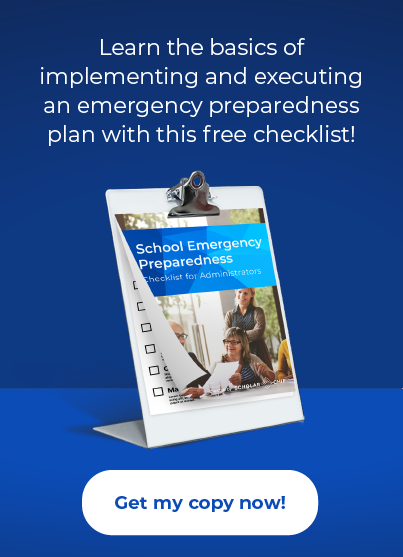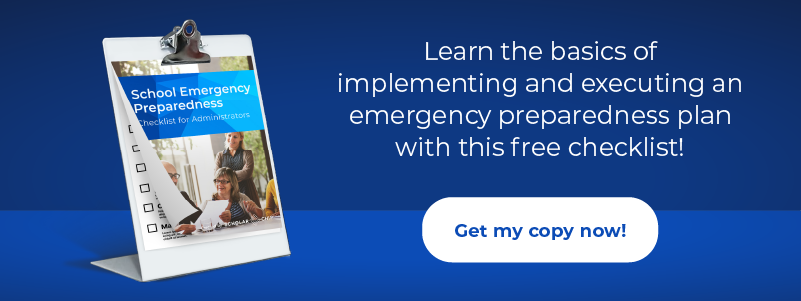Ensuring that your campus community knows how to prevent and react to emergencies is an essential part of your job. According to FEMA, emergency preparedness for schools has five components. The first is prevention, which means that you take precautions to make sure emergencies don’t happen in the first place. The next is protection, which involves mitigating the impact that a crisis, like a natural disaster, has on your students, faculty, and staff.
The last three steps are mitigation, response, and recovery. Mitigation means creating processes and campus improvements that lessen the loss of life and property damage. Response considers your response when an emergency is already in process, while recovery involves the aftermath of an emergency.
With so many moving parts, it’s no wonder that emergency preparedness for schools can feel like a tall order. Let’s discuss best practices for ensuring that your school is well-prepared for a variety of emergencies.
Assemble a team to evaluate the processes that you already have in place.
The world is constantly changing, and with change comes new dangers. While COVID-19 is clearly a priority in considering emergency preparedness for schools, not every emergency is of national discussion. There are likely other newly identified or overlooked dangers that may not have been included in your previous EOP plan. Alternatively, newer methods may exist that can better mitigate these security risks.
However, in order to identify new or unidentified risks, you need to assemble a team of stakeholders. This team can then evaluate the EOP that you already have to make sure that every threat is identified and that each response to emergencies is detailed well.
Train faculty, staff, and students.
One of the factors that can influence the effectiveness of your EOP is application. In some instances, faculty, staff, and students may not know how to act on your plans during an emergency. Other times, they need to practice safety processes to ensure that an emergency doesn’t happen. For instance, to prevent the spread of COVID-19, faculty and staff need to model social-distancing, mask-wearing, and hand-washing habits to students.
In addition to creating an EOP, you need to develop procedures that teach your campus community how to prevent, react, and respond to emergencies.
Build relationships with community personnel, including public safety officials.
Your emergency preparedness for schools will benefit considerably from a relationship with public safety officials in your area. Take their advice about considerations for your area or school—for instance, particular earthquake or landslide risk.
Furthermore, make sure to communicate with them about the technologies that you have in place at your school. Let’s say that you plan to implement ScholarChip technology that keeps track of your students’ whereabouts on campus. The One Card is a unique ID card that students use to open doors around campus. They swipe the card on a Secure Door Access reader wherever they’re supposed to be on campus.
After installation, let public safety officers know that you have this technology at your school. It will help them save time when evacuating students in an emergency situation.
Prepare to take care of everyone on your campus during an emergency.
You typically create EOPs with students, faculty, and staff in mind. But on a given day, other people are likely to also be on your campus. What about parents volunteering for a school function? Vendors? Repair people? Your EOP must include stipulations that make sure these visitors are accounted for as well.
ScholarChip’s Visitor Management system can simplify this identification. Whenever someone comes to campus, they’ll be logged into the system and provided a pass. Visitors shouldn’t be able to enter your campus unless they check in with this machine. This way, if an emergency situation arose, you would know about every visitor on your campus and ensure that they were evacuated safely.
Create a communication plan that enforces community trust in your EOP.
Transparency is a significant factor in developing an effective EOP. Let’s say that your community doesn’t know how your school will react to an emergency or that parents don’t know how to pick up their children after an incident at school. This lack of communication not only breeds distrust, but with panicked parents calling your school, it could also make the implementation of your plans less successful.
Practice your emergency preparedness procedures before an actual emergency.
In the same way that you train your faculty, staff, and students on how to react in emergencies, you also need to run them through drills regularly. Your emergency plan will be much more effective if you practice your processes. Basically, you don’t want your first run-through of an emergency procedure to be in actual emergency conditions.
As the COVID-19 pandemic has taught us, dangers that could affect our schools are ever-changing. That’s why it’s so important for administrators to evaluate and reevaluate their emergency preparedness for schools. ScholarChip technology can help you make sure that your evacuation plans and procedures are as thorough and effective as possible.
ScholarChip offers holistic school safety services aligned with CDC guidelines to help schools reopen amidst growing health concerns. Through our advanced technology, built and designed for the K-12 environment, schools can identify risks and mitigate the spread of infection. Our solutions include fever screening, visitor surveys, symptom and vaccine tracking, in-school contact tracing, alerts and notifications. Learn more about our advanced COVID-19 solutions or request a reopening strategy session today!


